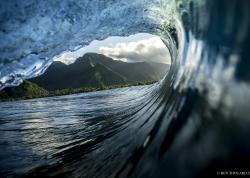5 Tips for Surf Photography

There's something to be said about capturing a breaking wave - locking yourself into a barrel with a surfer, stopping time - and capturing that precise moment on camera. Surf photography is a very demanding art form that doesn't only require technical skill, but high physical endurance and a great knowledge and understanding of the surroundings in and out of the water. Critical timing is everything when trying to engage with a surfer. Here are five tips to get you started in the right direction.
Tip 1: Safety First
Although it isn't a specific camera technique, safety and understanding your surroundings are huge assets to a striving surf photographer. I've seen it time and time again: first time surf photographers getting hurt really bad or nearly drowning after hitting the waves, anxious to take their new set-up in the ocean.
I have been in the ocean for most of my life surfing and photographing everything from small surf to the out of control double head shore breaking wave that you would never want be a part of. I have my limits and know when to say no. Rip currents, shallow sandbars, and a powerful under tow are only a few things that you need to be aware of when out in the lineup. I would highly recommend starting out in some smaller surf and getting used to the weight of your new setup in the water and to get a feel of what you can and cannot do in the ocean. And Hey! Some of my best surf photos were in perfect glassy conditions with waves only about a foot or two in height. There is no harm in starting off smaller and getting to know your gear before trying to go big right of the bat.
Being a avid swimmer plays another huge part in the role of a surf photographer. Being an experienced ocean swimmer is essential if you want to dive into the world of bigger surf photography or photographing and working with surfers in the water. Knowing where to compose yourself in a barreling wave while a surfer is coming at you is a crucial thing that only experienced surf photographers can decide in the blink of a eye.


Tip 2: Set it and Forget it
People new to the sport of surf photography often ask me what camera settings they should be using, especially for shooting shore break. My go-to advice, and what I still follow from time to time, is a no brainer - just "set it and forget it." In shutter priority mode (or "TV mode") set the shutter to 1/1000 of a second, set your ISO to Auto and your exposure compensation down 2/3rds of a stop (see tip #4). This setting will most likely yield excellent results, especially after sunrise and before sunset. I've captured some of my most memorable images with this setting, including an image that graced the September 2014 cover of Outdoor Photographer magazine.
One of the most confusing things for a newbie to the sport to encounter is trying to figure out settings in the ocean while trying to capture the beauty of a curling wave. This basic setting keeps things fun as a beginner until you feel comfortable and want to experience new ways of shooting in the water.


Tip 3: Hyper Focus
Another big question I get asked all the time is, "Where do I set my focus."
I highly recommend starting surf photography with a wide-angle lens like the Tokina 11-20 f2.8, which is and has been my favorite wide-angle lens for quite some time. The reason being, when you find that perfect spot where everything is in focus you just switch the lens to manual and lock it down by using a piece of painters tape. Then you're good to go and don't need to worry about focus for the rest of the session! You can only use this hyper focusing technique at these wider angles of view. I have found that any focal distance longer than 20mm will give you a false sense of focus and is better suited for auto focusing.
The magic hyper focus distance is 3 feet. It's worked for me in the past and still works for me today. We won't dive too deep into the definition of hyper focusing (and trust me that's opening a entire new can of worms), but just know that everything from 3 feet and beyond will be in focus. Obliviously, if you're using a higher Fstop (such as f11 where I like to roam around at) you will capture an image that has more depth of field than an image captured at f2.8.
How do I set this hyperfocal distance? I start by setting my camera to Aperture priority mode (or "AV mode") and then set the aperture to f7.1. This is a great aperture for shooting surf photos on crop sensor and full frame cameras. I measure out 3 feet from my car's license plate and stand there with the camera at that exact distance. Then I take a shot and zoom in to see if everything is sharp and to my liking. If it's all good to go I tape it down - easy as that! Of course, you can test out your focus on any other subject, but a license plate has great detail in the highlights and shadow areas, which will give you a great read out on how sharp your image is.
Utilizing hyper focusing will allow you camera to shoot faster without the delay in focus you'd experience if using autofocus. For a beginner, it strips away the confusion of focusing first and then firing and adds to the fun factor of why you wanted to get into surf photography in the first place.

Tip 4: Exposure Compensation
I touched on exposure compensation briefly in tip 2. Believe it or not, there are a ton of photographers out there (even experts) that don't know what exposure compensation is or how it could benefit their imagery in the surf.
Dropping your exposure compensation by 2/3rd of a stop or even a full stop when shooting directly shooting into the sun works wonders! It helps retain more detail, helping you capture a less blown out image. And if you're working in the water, say with a Sony A7rII camera, the amount of shadow and highlight recovery you can bring back is jaw dropping thanks to this simple technique. Dropping your "expo comp" also helps raise your Fstop, especially in dark shooting conditions like the morning hours before the sun rises. Instead of shooting at f2.8 you might be at f4 with shutter speed of 1/1000 because of the drop.


Tip 5: Get a Reliable Surf Housing
I've seen it happen a few times. A friend of mine and even someone I recently met at the beach went out and bought the best camera and lens money could buy. Then they bought the cheapest water housing they could find on Ebay, using that to protect their 3-4 thousand dollar camera investment. And that's where they went wrong.
They take the new kit out in big surf and get slammed a few times. The buttons start sticking, they can't change their ISO or shutter speed, and then the water housing starts leaking. This, in turn, destroys the electronics in the camera. If you're going to invest in an awesome camera body and lens, invest in a quality surf housing that has been proven and can take a beating in some heavy surf.
I am an ambassador for Aquatech imaging solutions and been part of the team for about 4 years now. I have trusted my gear in their housing systems 100% - and I'm not just saying that - from when I started out with Nikon to the Sony mirriorless camera bodies I use now. Each and every water housing I have tested and used the years has been like a little tank in the water. Water damage to my camera is the last thing I care about in the water. More focus can be put on capturing that epic image and just plain out having fun! Investing properly in your gear is not an overstatement.

![]()
Take a look at Bluewater's full line of Aquatech Surf Housings.
About the Author

Extreme photographer Stan Moniz was a water baby at birth, raised in the quiet surf town of Waialua, Hawaii. He became a professional body boarder at the age of 18 and remains an avid surfer. His passion for music brought him to Southern California in 2000, and after a very successful career in a professional touring band, he ultimately set his sights on his other great passion: photography. In 2010, he reacquainted himself with his love for the ocean, adventure and capturing the beauty of the world we live in. Stan, now equipped with a camera, travels the earth, capturing those timeless moments to share with the world.
www.stanmoniz.com | www.facebook.com/stanmonizphotography
Instagram: @StanMoniz | Twitter: @StanMoniz
RECOMMENDED ARTICLES
SUPPORT THE UNDERWATER PHOTOGRAPHY GUIDE:
The Best Service & Prices on u/w Photo Gear
 Visit Bluewater Photo & Video for all your underwater photography and video gear. Click, or call the team at (310) 633-5052 for expert advice!
Visit Bluewater Photo & Video for all your underwater photography and video gear. Click, or call the team at (310) 633-5052 for expert advice!
The Best Pricing, Service & Expert Advice to Book your Dive Trips
 Bluewater Travel is your full-service scuba travel agency. Let our expert advisers plan and book your next dive vacation. Run by divers, for divers.
Bluewater Travel is your full-service scuba travel agency. Let our expert advisers plan and book your next dive vacation. Run by divers, for divers.































